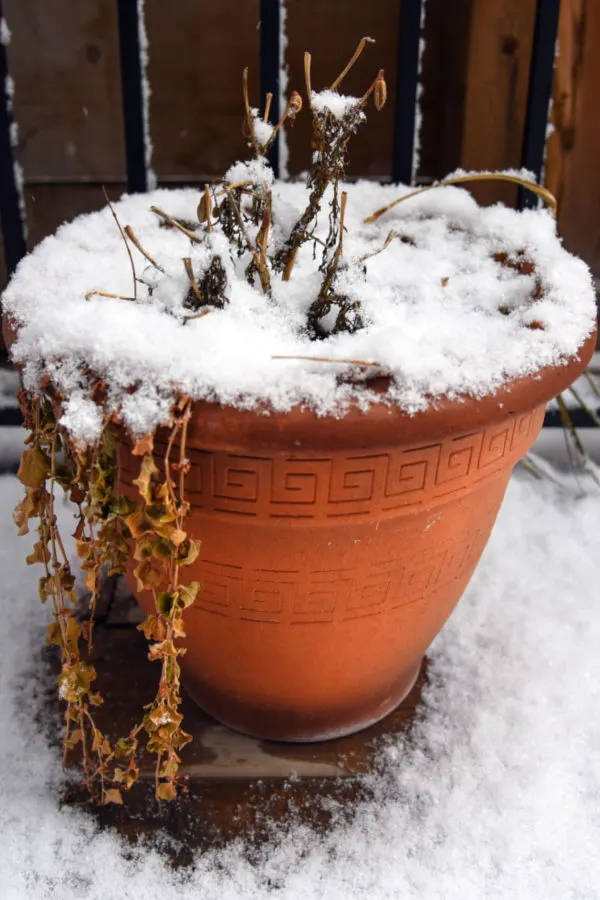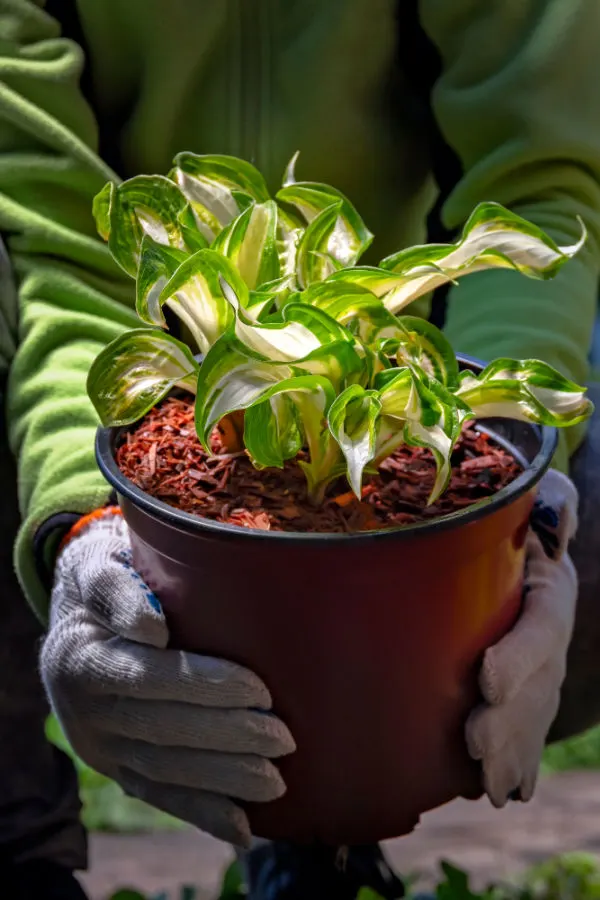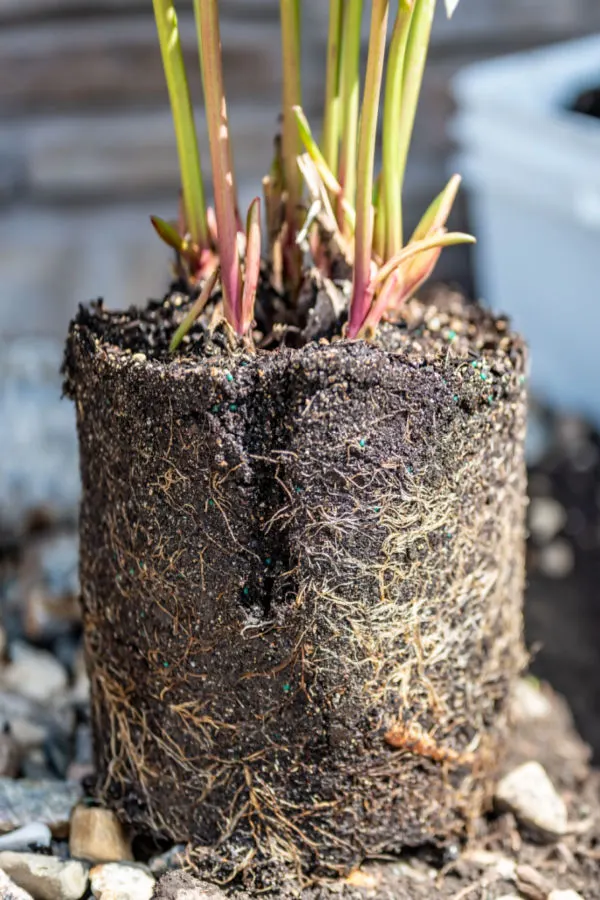Looking for a way to protect and save your potted perennial plants from the cold, harsh winter months?
Growing perennials in containers and hanging baskets is becoming more popular with each passing year. Whether it’s hostas, daylilies, ornamental grasses, evergreens or everbearing strawberries, not only can perennials provide big interest and color in their pots, they also have the advantage of being able to grow again year after year. Well, that is, as long as you can protect them over winter!
Unlike petunias, impatiens and other annual plants that die off with the first frost or cold snap in the fall, perennials, if given the proper care, will come back to life in the spring. That can mean huge savings when it comes to not having to replace the plants in pots and baskets year after year.

The key to success, however, all comes to down to providing that all important protection. Just because a plant is winter hardy in your area, it doesn’t mean it can survive outdoors in a container or basket. In fact, most perennials are completely unable to survive winter when growing in a pot.
Why Potted Perennials Need Extra Protection – Save Potted Perennials Over Winter
When a perennial grows in the ground, its roots can grow wide and deep. It also has the benefit of the surrounding soil, which offers excellent protection against the constant thawing and freezing the winter months bring.
In addition, most perennial flower beds have a covering of mulch on top of the soil. That helps to extend winter protection even more. Unfortunately, containers just don’t protect a plants roots as well as being in the ground.
No matter how big, thick or insulated a container might be, it has the disadvantage of being exposed to the weather on all sides. As soon as the temperatures turn cold, the soil (and the plant’s roots) freeze. And as soon as it warms, they both thaw just as quickly.

This constant freezing and thawing takes its toll. And when it occurs over and over, even the hardiest of perennials will suffer heavy damage. Actually, in most cases, they completely die out over the winter.
The winter elements often take a toll on the containers too. Depending on what they are made of, they often freeze and break with the cold as well. It’s certainly easy to see why some type of protection has to occur to keep both your perennial plants and their holding vessels in good health.
The good news is that overwintering perennial plants in pots isn’t difficult. Nor is it costly or extremely time consuming. With that in mind, here are 3 great methods for saving your perennials in pots over winter with success!
3 Great Ways To Save Potted Perennials Over Winter
#1 Burying Pots In The Ground
One of the easiest ways of all to protect your potted perennial plants is by planting them into the earth – pots and all! By digging a hole into the soil and burying the pot and plant, you give them nearly all of the advantages of traditional bed planted perennials.
The surrounding soil provides excellent thermal protection for the container plant’s roots. It allows the plant to have far less freezing and thawing events throughout winter. In addition, it also adds some protection for the pot too.

To bury plants, find a semi-protected area for best results. Flowerbeds up against a house or a protected corner of the garden work well. To “plant”, simply dig a hole down into the soil so that it covers the pot to the top of it’s rim.
Keeping It Simple…
There is no need to add soil amendments or compost to the hole. You are simply using the ground to store the plant and pot. This works best with all weather pots. Fragile pots should not be buried as they can still break from the freezing and thawing.
Once the plant is set down in the hole, cover the rim and base of the plant with three to four inches of mulch. This will help insulate the plant’s roots even more. Next spring, as temperatures rise, dig out the plant, wash off the container, and watch it grow!
This method works best for small to medium size container plants 12 inches or less in depth. This size can be easily dug into an open space with little effort. For overly large planters, you will want to use the last method in the article, which is overwintering in a protected space indoors or in a garage.
#2 Transplanting Perennials Into A Holding Bed – Save Potted Perennials Over Winter
Another great way to overwinter perennials is to plant just the plants into a temporary holding space in your flowerbeds or garden. This works great if you have a lot of container plants, or if you have fragile containers.

Most potted plants will pop out of their container quite easily by the end of the growing season. There is no need at this point to break apart the roots, just dig a hole equal to the size of the container plant’s root ball and place into the soil.
Much as with covering entire pots, cover the plant with three to four inches of mulch. Next spring, you will be able to dig up the plants and replant into your pots. This method also has the advantage of allowing you to split overgrown perennials next spring to create multiple plants. (See : How To Divide Perennials)
This method should be done in mid to late fall before the soil begins to freeze. This allows the soil plenty of time to sink in around the root ball to protect it.
#3 Overwintering Indoors – Save Potted Perennials Over Winter
The third and final method to overwinter your perennials is to move them indoors. If you have overly large plants or perennials that are marginally hardy, overwintering indoors will give them the best chance of success.
This method works great for large ornamental grasses and evergreens that are not winter tolerant. An unheated basement or a protected garage or barn space are all excellent options.

By overwintering in a protected but unheated space, the perennials will go dormant as they would outdoors, but with added protection. When overwintering indoors, water every two to three weeks to keep the soil slightly moist.
Before the threat of a hard freeze, move plants into their “winter” home. For perennials whose foliage dies back, simply cut the leaves back to the base and apply a few inches of mulch. They will not need to have a tremendous amount of light at this point.
As the weather warms back up, you can move the plants back outdoors and get to enjoy them for another entire growing season. Here is to protecting your potted perennial plants and saving them over the winter with success!
Follow Our Facebook Page For Great Gardening Tips And Advice! This Is My Garden Facebook Page
This Is My Garden is a garden website created by gardeners, for gardeners. Jim and Mary Competti have been writing gardening, DIY and recipe articles and books and speaking for over 15 years from their 46 acre Ohio farm. They publish three articles every week, 52 weeks a year. Sign up today to follow via email, or follow along!

